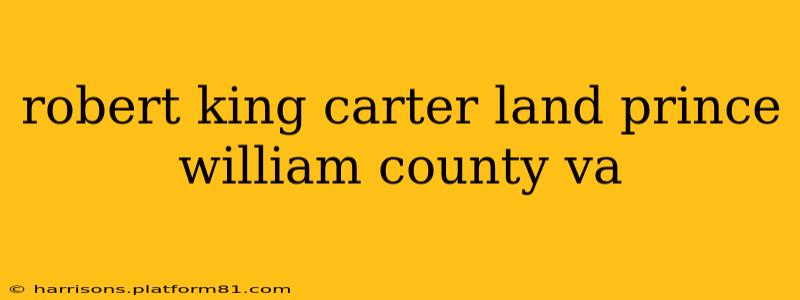Robert "King" Carter, a prominent figure in 18th-century Virginia, left an undeniable mark on the landscape of the Commonwealth. His vast landholdings, including significant tracts in Prince William County, continue to fascinate historians and genealogists alike. Understanding the extent and legacy of his land requires delving into historical records, exploring the complexities of land ownership in colonial Virginia, and piecing together the fragmented puzzle of his expansive estate.
Who Was Robert "King" Carter?
Before exploring his land in Prince William County, it's crucial to understand the man himself. Robert "King" Carter (1663-1732) wasn't a king in the literal sense, but his immense wealth and influence earned him the moniker. He was a powerful planter, politician, and businessman who amassed a vast fortune through tobacco cultivation and shrewd investments. His influence extended throughout Virginia's political and social circles, solidifying his place as one of the colony's most significant figures. His legacy is intertwined with the history of slavery and the complex social structures of colonial Virginia.
What Land Did Robert King Carter Own in Prince William County?
Pinpointing the precise boundaries of Carter's Prince William County holdings requires meticulous research in land records, which can be challenging due to the passage of time and the evolution of property lines. However, historical accounts indicate he held substantial acreage in the county, often acquired through land grants, inheritance, and strategic purchases. These lands likely contributed to his overall wealth and influence in the region. Unfortunately, a definitive map depicting all his Prince William County properties is not readily available, demanding further archival investigation.
How Can I Find Records of Robert King Carter's Land in Prince William County?
Researching Robert "King" Carter's land in Prince William County necessitates exploring various historical resources. The Prince William County Courthouse archives are a prime starting point. These archives might contain deeds, land patents, tax records, and other documents that shed light on his property ownership. The Library of Virginia also holds extensive collections relevant to Virginia's colonial history, offering invaluable resources for researchers. Genealogical societies and online databases dedicated to Virginia land records can also prove helpful in this research endeavor.
Were there any disputes or legal battles concerning Robert King Carter's land?
Given the scale of Robert "King" Carter's landholdings and the complexities of land ownership in colonial Virginia, it's highly probable that disputes and legal battles occurred over his property. These conflicts could have stemmed from boundary disagreements, inheritance issues, or even contested land grants. Uncovering these legal wranglings would require painstaking research in court records and other legal documents of the era. Further investigation into colonial court records might unearth details about these conflicts.
What is the current status of land once owned by Robert King Carter?
The land once owned by Robert "King" Carter has, over centuries, been subdivided, sold, and redeveloped. Tracing its current ownership requires extensive research, potentially involving multiple property records and title searches. Much of the land may be privately owned, while portions might be part of public parks or other areas. Its current use likely bears little resemblance to its 18th-century agricultural past.
Conclusion: A Continuing Legacy
The story of Robert "King" Carter's land in Prince William County is a captivating journey into the history of colonial Virginia. While definitive answers regarding the precise location and extent of his holdings require dedicated archival research, piecing together this historical puzzle provides a valuable glimpse into the life of a powerful colonial figure and the evolution of land ownership in the region. This exploration also highlights the importance of preserving historical records and using them to better understand the past.
